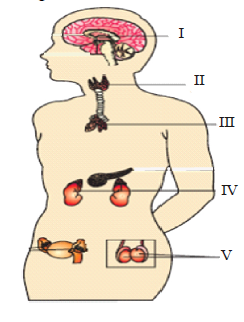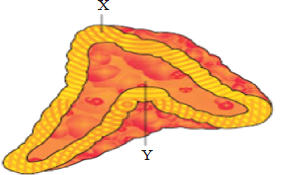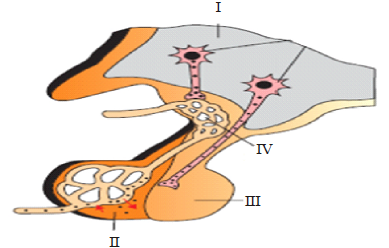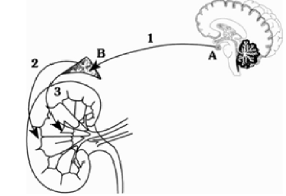Please see Chapter 22 Chemical Coordination and Integration Exam Questions Class 11 Biology below. These important questions with solutions have been prepared based on the latest examination guidelines and syllabus issued by CBSE, NCERT, and KVS. We have provided Class 11 Biology Exam Questions and answers for all chapters in your NCERT Book for Class 11 Biology. These solved problems for The Living World in Class 11 Biology will help you to score more marks in upcoming examinations.
Exam Questions Chapter 22 Chemical Coordination and Integration Class 11 Biology
Objective Type Questions
Question. A gorilla like appearance with huge hands and legs is due to abnormal secretion of
(a) FSH
(b) LH
(c) LTH
(d) GH
Answer
D
Question. Which of the following hormone is required for the maintenance of corpus luteum ?
(a) Progesterone
(b) Estrogen
(c) FSH
(d) LH
Answer
D
Question. Ovulation in humans is controlled by
(a) FSH and LTH
(b) FSH and G.H
(c) LTH and LH
(d) FSH and LH
Answer
D
Question. MSH is secreted by
(a) pars intermedia
(b) pars tuberalis
(c) pars distalis
(d) pars nervosa
Answer
A
Question. Deficiency of vasopressin primarily results in
(a) increased volume of urine.
(b) decreased volume of urine.
(c) excessive secretion of urochrome.
(d) change in pH from acidic to alkaline range.
Answer
A
Question. Sleep-wake cycle and menstrual cycle are maintained by
(a) progesterone
(b) melatonin
(c) oxytocin
(d) MSH
Answer
B
Question. Which hormone helps in reabsorption of water from kidney?
(a) ADH
(b) STH
(c) ACTH
(d) TTH
Answer
A
Question. Which of the following hormone acts upon the renal tubule and blood capillaries ?
(a) Glucagon
(b) Aldosterone
(c) Vasopressin
(d) Glucocorticoids
Answer
C
Question. Which of the following hormone opposes parathormone ?
(a) ADH
(b) STH
(c) Thyroxine
(d) Thyrocalcitonin
Answer
D
Question. Thyroxine acts on every organ of the body, except
(a) adult brain
(b) testis
(c) thyroid itself
(d) bones
Answer
B
Question. Which of the following gland is often referred in connection with AIDS?
(a) Thymus
(b) Thyroid
(c) Adrenal
(d) Pancreas
Answer
A
Question. Which one of the following disease is caused by the under secretion of cortisol hormone?
(a) Anaemia
(b) Addison’s disease
(c) Hyperglycemia
(d) Mental retardation
Answer
B
Question. Triple ‘F’ gland for flight, fright and fight is
(a) thyroid
(b) thymus
(c) pituitary
(d) adrenal
Answer
D
Statement Type Questions
Question. What of the following is correct about calcitonin ?
(a) It contains iodine.
(b) It is an amino acid.
(c) It is released from parathyroid.
(d) It is released from thyroid gland.
Answer
D
Question. Which of the following statements is correct in relation to the endocrine system?
(a) Organs in the body like gastrointestinal tract, heart, kidney and liver do not produce any hormones.
(b) Non-nutrient chemicals produced by the body in trace amount that act as intercellular messenger are
known as hormones.
(c) Releasing and inhibitory hormones are produced by the pituitary gland .
(d) Adenohypophysis is under direct neural regulation of the hypothalamus.
Answer
B
Question. One similarity between enzymes and hormones is that
(a) both are proteins.
(b) both can be used again and again.
(c) both are used in minute amount.
(d) both act at a particular pH.
Answer
C
Question. Norepinephrine
(i) is released by sympathetic fibres.
(ii) is released by parasympathetic fibres.
(iii) increases the heart rate.
(iv) decreases blood pressure.
Which of the above said statements are correct?
(a) (i) and (ii)
(b) (i) and (iii)
(c) (ii) and (iii)
(d) (ii) and (iv)
Answer
B
Question. Which of the following statement is correct regarding glucagon hormone ?
(a) It has opposite effect to that of insulin.
(b) It converts glucose to glycogen.
(c) It is given to diabetic patients.
(d) It is formed by b-cells of pancreas.
Answer
A
Question. Which one of the following statement is correct?
(a) Endrocrine glands regulate neural activity and nervous system regulates endocrine glands.
(b) Neither hormones control neural activity nor the neurons control endocrine activity.
(c) Endocrine glands regulate neural activity, but not vice versa.
(d) Neurons regulate endocrine activity, but not vice versa.
Answer
A
Question. Which of the followings is the more scientific definition of hormone?
(a) They are extracellular messengers.
(b) They always act at distantly located target organ.
(c) They are the products of well organized endocrine glands.
(d) They are non-nutrient chemicals that act as intercellular messengers.
Answer
D
Diagram Type Questions
Question. The given diagram represents the location of human endocrine glands I, II, III, IV and V.

Which of the following gland is correctly matched with their secretions?
| Hormones | Their secretions | |
| A | I | Melatonin |
| B | II | Thymosin |
| C | III | Epinephrine |
| D | IV | Aldosterone |
| E | V | Testosterone |
(a) I, II and III only
(b) I, IV and V only
(c) II, IV, and V only
(d) II, III and V only
Answer
B
Question. The label X represents ___i_____ and the hormone released by it is _____ii______. Identify (i) and (ii)

(a) i- Adrenal cortex, ii- Epinephrine
(b) i- Adrenal cortex, ii- Aldosterone
(c) i- Adrenal medulla, ii- Epinephrine
(d) i- Adrenal medulla, ii- Aldosterone
Answer
B
Question. The Hypophyseal portal system transports releasing and inhibiting hormones from the hypothalamus into which of the following parts marked in I, II, III and IV.

(a) I
(b) II
(c) III
(d) IV
Answer
B
Direction : The endocrine glands A and B in the given figure represent ___ (i) ____ and ____ (ii) ____ respectively.

Question. Identify (i) and (ii)
(a) i- Pituitary gland , ii- Adrenal gland
(b) i- Hypothalamus, ii- Pituitary gland
(c) i- Hypothalamus, ii- Adrenal gland
(d) i- Pituitary gland, ii- Hypothalamus
Answer
A
Critical Thinking Type Questions
Question. In hormone action, if receptor molecules are removed from target organ, the target organ will
(a) continue to respond to hormone.
(b) not respond to hormone.
(c) continue to respond but requires higher concentration.
(d) continue to respond but in the opposite way.
Answer
B
Question. Which hormone is related to mineral metabolism but is not a peptide / protein in nature ?
(a) PTH
(b) ANF
(c) Aldosterone
(d) All of the above
Answer
C
Question. A decrease in the level of estrogen and progesterone causes
(a) growth and dilation of myometrium.
(b) growth of endometrium.
(c) constriction of uterine blood vessels leading to sloughing of endometrium or uterine epithelium.
(d) release of ovum from the ovary.
Answer
C
Question. Which one is different from the category of other three?
(a) Gastrin
(b) Ptyalin
(c) Secretin
(d) Glucagon
Answer
B
Question. Hormones produced by anterior lobe of pituitary
(a) control calcium level in blood.
(b) stimulate thyroid and other endocrine glands.
(c) initiate alarm reaction.
(d) regulate water balance in body.
Answer
B
Question. Which of the following hormone helps a person who suffers from a marked fall in blood pressure ?
(a) Insulin
(b) Thyroxine
(c) GH
(d) Adrenaline
Answer
D
Question. Which of the following hormones are identical?
(a) ACTH and adrenaline
(b) hCG and progesterone
(c) Calcitonin and Oxytocin
(d) Vasopressin and ADH.
Answer
D
Question. Which hormone promotes cell division, protein synthesis and bone growth?
(a) GH
(b) ADH
(c) ACTH
(d) PTH
Answer
A
Question. A person who has protruding eyes, tachycardia and higher body temperature is suffering from
(a) cretinism
(b) hyperthyroidism
(c) myxoedema
(d) acromegaly
Answer
B
Question. When a boy goes through puberty, the steroid hormone testosterone puts hair on his chest by
(a) interacting with DNA in the nuclei of cells.
(b) causing cells to change shape.
(c) altering the permeability of plasma membranes.
(d) triggering nerve impulses in cells.
Answer
A